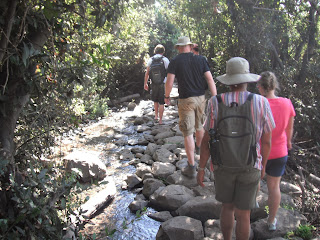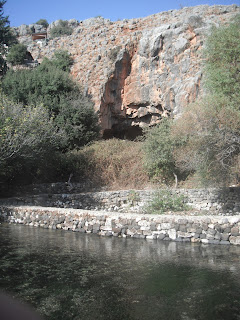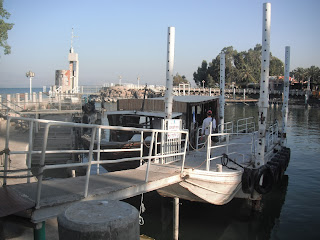Today we travelled north. From the
shores of the Sea of Galilee we travelled north all of the way to Hazor, Dan
and Caesarea Philippi. In my opinion this is one of the most beautiful areas of
Israel. Again like the other days we have talked about a lot of stuff, but I
cannot include all of that here today so I am just going to focus on a couple
things.
We started going across the Sea of Galilee on a boat!
Hazor was a very important city. Located
along the road headed north it controlled a good portion of the traffic that
went from Damascus the land between. There have been found writings that
mention Hazor and in writings from Egypt it referred to the ‘King of Hazor’.
King was not as common as a title in that particular age and other cities and
area officials were referred to as rulers.
This suggests that Hazor was in a place of prominence over the other
cities and might even have a city-state like status as is seem with larger
cities in Syria.
Hazor is a very large Tel compared to
others in the area. 200 acres is the approximate size of the Tel. It also has
20 destruction and settlement layers that are added evidence to the importance
of the site.
In the mid 13th century
BCE there is a significant destruction by fire layer. The severity of the
destruction layer seems like it could coincide well with the description of the
conquest of Hazor in Joshua 11 and following. But there are many deep issues
that are tied into this story and understanding it well.
Over the past couple months we have been wrestling a lot with the question of how do we appropriately and accurately relate the Bible to the evidence on the ground and what do we do when the two don’t seem to go together. This is a deep question and I have found that for some whose faith relies completely on the Bible alone it can be quite startling and upsetting.
To make it clear, I am at a point where I can say that God is very real and active in my life. The Bible is still very important, but I have seen and experienced how God has been and is faithful in my life and in the lives of the people around me. God stands existentially above the world and just because there are questions and issues that are raised with the text and the way we relate to it and to history cannot change God. I think that it is important to wrestle with these questions in a way that draws us deeper into understanding of who God is and who we are called to be. It is often in the wrestling that we learn and grow.
 |
| The destruction by fire was hot enough to shatter the basalt foundation stones |
The first issue that we talked about was the issue of the evidence on the group not lining up with the text in the Bible. In this case it goes back to the dating of Jericho and the evidence that is found there. One of the archaeologists there, Kathleen Kenyon, has concluded that there wasn’t a city at the site of Jericho at that time if we line the dates up with the destruction layer at Hazor. I wish there was a clear answer and a clear way to explain the tension between dating the two sites. Both cities have destruction layers that seem to fit well with the Joshua story and yet the dating of those layers is the issue.
There are a couple ideas of how this works out. First of all, maybe we are reading the texts out of their genre. It is extremely common for kings to return to their countries after battle and write their epics about battle and the amazing thing that they had done. That they had wiped out ______, and that they fought with great valour, even if the evidence on the ground is clearly that they just escaped with their lives and maybe even lost a large portion of their army! If that was common in other nations at that time, including in Egypt, then should we be surprised to see that the Israelites, who had just come from Egypt, maybe recorded their conquest stories in a similar way? Secondly, maybe the reading and dating of the Tels are slightly off. Maybe there are finds and things that haven’t been found yet
 |
| mud bricks from the walls |
The first issue that we talked about
was the issue of the evidence on the group not lining up with the text in the
Bible. In this case it goes back to the dating of Jericho and the evidence that
is found there. One of the
archaeologists there, Kathleen Kenyon, has concluded that there wasn’t a city
at the site of Jericho at that time if we line the dates up with the
destruction layer at Hazor. I wish there
was a clear answer and a clear way to explain the tension between dating the
two sites. Both cities have destruction layers that seem to fit well with the
Joshua story and yet the dating of those layers is the issue.
There are a couple ideas of how this
works out. First of all, maybe we are reading the texts out of their genre. It
is extremely common for kings to return to their countries after battle and
write their epics about battle and the amazing thing that they had done. That
they had wiped out ______, and that they fought with great valour, even if the
evidence on the ground is clearly that they just escaped with their lives and
maybe even lost a large portion of their army! If that was common in other
nations at that time, including in Egypt, then should we be surprised to see
that the Israelites, who had just come from Egypt, maybe recorded their conquest
stories in a similar way? Secondly, maybe the reading and dating of the Tels
are slightly off. Maybe there are finds and things that haven’t been found yet.
The second issue that is often
brought up with these stories is a larger one to swallow. I have been
struggling to figure out what is going on when God commands the people of
Israel to wipe out entire groups of people. In the conquest it happens a couple
times, all the way up to and possibly a little behind the time when Elijah
wipes out the 450 prophets of Baal. How do we settle with these? I don’t want
to just skip over them, because they were recorded for a reason, and maybe
there is a more important reason for this that we understand.
In the story of Hazor, all the people
of the city are killed, including the women and the children. They killed
everything that moved and burnt it to the ground.
Why?
I don’t know.
Part of it doesn’t seem right that
God would approve of the killing of so many people, but maybe in God’s
sovereignty there was a deeper reason for it. Maybe someone did something or
the city was inclined to believe or act in such a way that was not helpful to
the Israelites. I don’t know. Is this just? By our standards, no. But is this Justice, I don’t know but maybe.
God used the Assyrians to come in and take Israel to exile, God uses other
nations to teach the Israelites, maybe this is a reverse of that?.... Or maybe our definition of justice is
different that of theirs.
 |
| Oldest Arch gate still intact. From about the time of Abraham |
In Tell Dan we talked about city
gates. There is the oldest intact arch gate in the world found here. It is made
out of mud brick and was filled in by the people who lived there because it was
deteriorating due to the moisture, but because it was buried, it still exists
today.
The city gates were an important
people. The elders of the city were to judge in the city gates. Kings and
officials sat in gates. Guests were welcomed and taking in. Decisions were made
and disputes were settled, but justice instead of lining up with the idea of
individual rights and responsibilities that is common in the West today,
justice was lined up with caring for the poor, the widow, the orphan and the
stranger in the camp and ultimately took the entire community into
consideration.
First of all the judging was kept as
local as possible, and with small communities it was more than likely that the
people who were to judge, the older men, in the city gates would know everyone
and everything about the community. This
made me think of heaven being compared to a city and that there are city gates
where judging takes place. Maybe John is drawing a parallel as in these judges
were suppose to know the people that God judges us and knows everything about
us and Jesus is the one there interceding on our behalf. The other interesting thing that was pointed
out was that the judging took place in the open-air. Other than being a public
affair and limited to day-light, it was more importantly done before God,
before the heavens. God is watching, and God is a God of justice.
Job 29:7-17 is a beautiful description
of a guy who takes justice seriously.
 |
| sitting inside the city gate |
This led to a discussion on some of the more difficult commands that we find in the Bible. Leviticus 18 was one passage that we looked at. It is the chapter about sexual misconduct. It was pointed out that what is forbidden is what wasn’t life giving and/or adds chaos to inheritance. It was for the better of the community that these things don’t happen.
We then looked at a more often confusing passage, Deuteronomy 18:18. This verse states that if a virgin is raped that that the man must pay the bride price, marry her and cannot divorce her. In our modern culture this sounds like the worst thing that could possibly happen! It sounds like it punishes the woman more than anything else. But in the ancient near east mindset, this was the best possible outcome. If she was not to marry him, she would likely not get married; she would be like a widow for the rest of her life. She would have no way to support herself and ultimately would become a drain on the resources that the town has. But to make the man marry her requires of the man to care for her by providing for all of her needs plus giving her sons so that they can support her after he dies. Is this a better picture of justice? The widow is cared for, the town can continue to function, grow and survive. I wonder how drastically our culture would change if we changed our idea about justice to being the good of the entire community than just our own individual rights and responsibility? What would it look like to be the voice for those who don’t have a voice, the widow, the poor, the discriminated, the outcast, the odd one out, the orphan, the stranger within our gates?
 |
| one of the 4 head springs that make up the head waters of the Jordan |
 |
| Banais is another spring, it used to flow out of the cave in the rock and was connected with pagan worship |
 |
| the last stop of the day was a look out point in Northern Israel |
 |
| overlooking Syria |
 |
| Mount Hermon in the north |
 |
| it used to be a military outpost. some of the military bunkers and tunnels were still there and open |
 |








This is always an interesting part in Judges 3, makes you think about peace and war:
ReplyDeleteThese are the nations the Lord left to test all those Israelites who had not experienced any of the wars in Canaan (he did this only to teach warfare to the descendants of the Israelites who had not had previous battle experience): the five rulers of the Philistines, all the Canaanites, the Sidonians, and the Hivites living in the Lebanon mountains from Mount Baal Hermon to Lebo Hamath. They were left to test the Israelites to see whether they would obey the Lord’s commands, which he had given their ancestors through Moses.